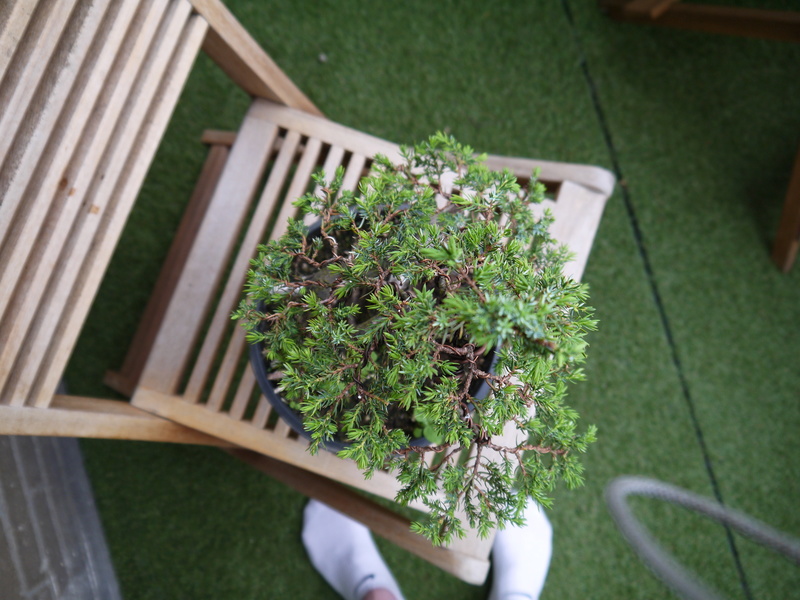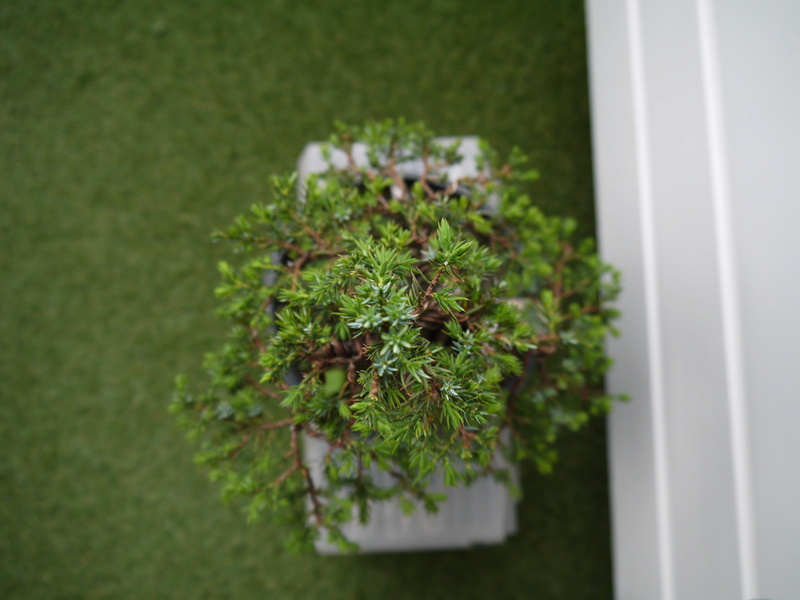Juniper needles turning brown
5 posters
Page 1 of 1
 Juniper needles turning brown
Juniper needles turning brown
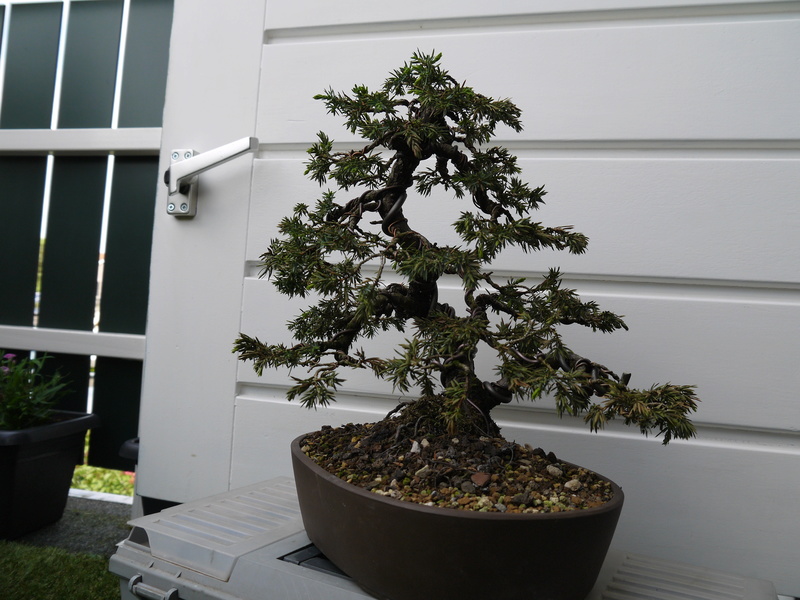

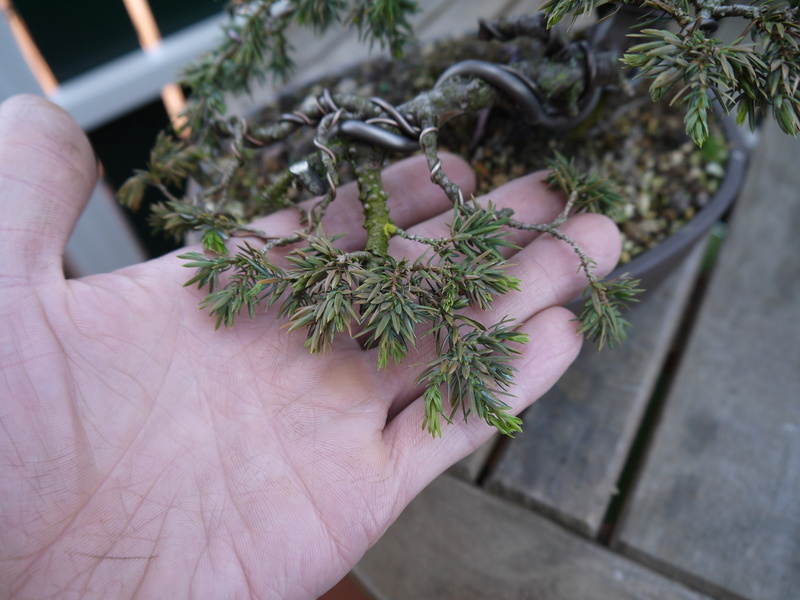
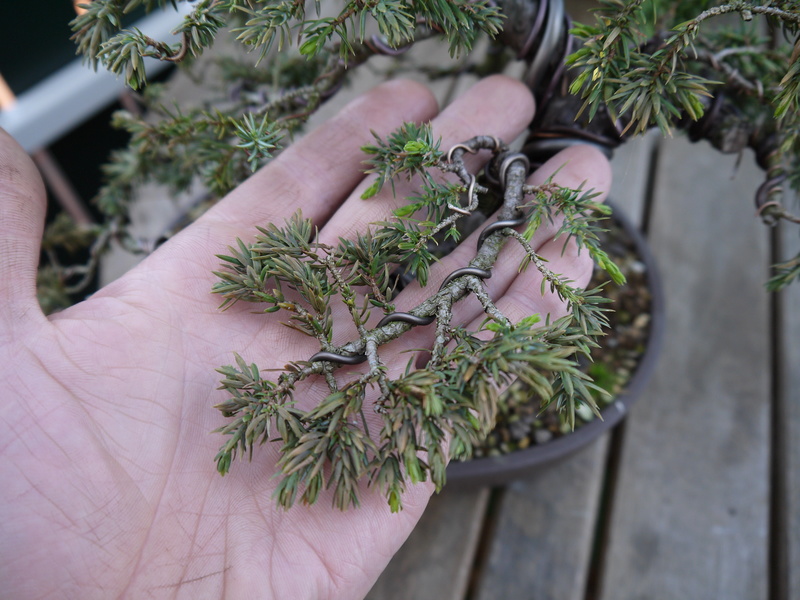
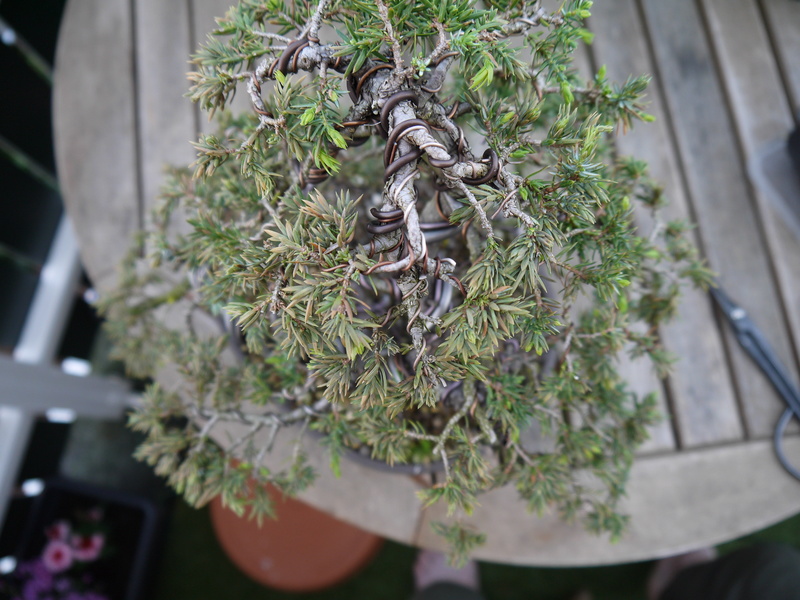
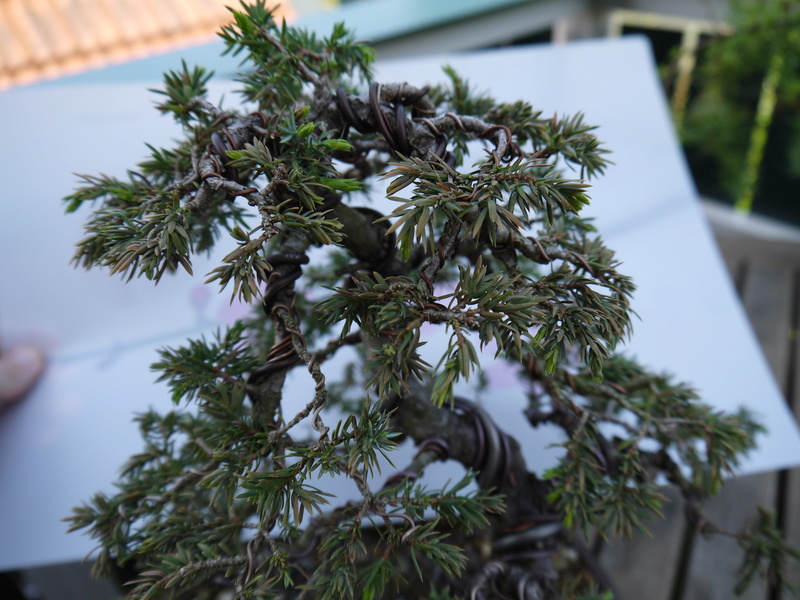
Hi Everyone
I'm a bit of a newby with bonsai, its my first time posting here and I hope someone is able to give me some advise on my tree. For a few months now some needles have been turning brown and drying out. I wasn't so worried about this as it wasn't so many and spread over the whole tree.
Yesterday I noticed that it seemed to be spreading round the tree, new growth and old needles turning brown. They still feel okay, not dried out but visually the tree isn't looking healthy, Any advise on how to deal with it would be appreciated.
Regards
Glen
Last edited by Glen on Sat Jul 22, 2017 12:26 pm; edited 3 times in total (Reason for editing : adding picture)
Glen- Member
 Re: Juniper needles turning brown
Re: Juniper needles turning brown
Sounds like a watering problem.
More information is needed though.
Like is it outside?
What kindi of soil is it planted in?
More information is needed though.
Like is it outside?
What kindi of soil is it planted in?
M. Frary- Member
 Re: Juniper needles turning brown
Re: Juniper needles turning brown
Thanks for your reply
The tree is kept outside and is in an akadama/Kanuma mix around 60/40. It has been warm here in the Netherlands over the past week, the tree has been watered and misted in the evenings every day.
The tree is kept outside and is in an akadama/Kanuma mix around 60/40. It has been warm here in the Netherlands over the past week, the tree has been watered and misted in the evenings every day.
Glen- Member
 Re: Juniper needles turning brown
Re: Juniper needles turning brown
There are two things you should check. Have you looked for spider mites? Little brown or red critters that are so small they are difficult to see without a magnifying glass. You can tell if you have them by holding a white piece of paper under the branches and taping on the top of the branches with the open hand or a wide paint brush. Inspect what falls out of the branches and see what falls on the paper. They are small and appear like a kind of dust but if you look long enough the dust moves. This is the appearance of Spider mites and should be treated with the appropriate insecticide, and no I do not recommend any of them check with your locals.
The second is your soil mix seems to be made of elements that break down into a substance that looks like mucus. Water is not the problem so much as it is drainage. I know I once more face the wrath of the bonsai elite but I feel in my experience that akadama is one of the worst things to be foisted on the bonsai community since the advent of the traveling bonsai master selling his wares as God's gift to bonsai. When was the tree repotted? Junipers can handle a lot of abuse but I have found once the roots start going down hill you have to deal with the problem.
By the way; this is a very nice and beautifully styled Juniper.
The second is your soil mix seems to be made of elements that break down into a substance that looks like mucus. Water is not the problem so much as it is drainage. I know I once more face the wrath of the bonsai elite but I feel in my experience that akadama is one of the worst things to be foisted on the bonsai community since the advent of the traveling bonsai master selling his wares as God's gift to bonsai. When was the tree repotted? Junipers can handle a lot of abuse but I have found once the roots start going down hill you have to deal with the problem.
By the way; this is a very nice and beautifully styled Juniper.

Vance Wood- Member
 Re: Juniper needles turning brown
Re: Juniper needles turning brown
Thx for your response and kind words, I bought this tree in the beginning of 2016 and it was repotted at the beginning of april in this mix of akadama and kanuma. It also had its first styling around this time too, I know, I know, but as a newby with a new tree I just couldn't wait.
but last year the tree responded well and this year too although I could notice that some branches were not so vigorous as others.
I have just carried out the spider mite test(don't knw why I didn't think of this myself, I have heard of this before) but there was no signs of the spider mites on the paper.
I am curious about the soil myself, and the root system, but as its the middle of summer here im not sure if its a good idea to remove the tree from the pot.
Regards
Glen
but last year the tree responded well and this year too although I could notice that some branches were not so vigorous as others.
I have just carried out the spider mite test(don't knw why I didn't think of this myself, I have heard of this before) but there was no signs of the spider mites on the paper.
I am curious about the soil myself, and the root system, but as its the middle of summer here im not sure if its a good idea to remove the tree from the pot.
Regards
Glen
Glen- Member
 Re: Juniper needles turning brown
Re: Juniper needles turning brown
What are good soil options for a juniper growing in Europe ?
Glen- Member
 juniper needles turning brown
juniper needles turning brown
There is nothing wrong with the soil you are using. Akadama is fine. I wonder if there has been a blackfly or greenfly infestation?
We have also had very warm weather and some of mine are looking a bit jaded, but they are ok. What fertiliser are you using? When you say that it was re potted how was it done? Did you remove a lot of root? There are a lot of clubs in Holland I would look for one and take it to ask their advice,
Geoff.
We have also had very warm weather and some of mine are looking a bit jaded, but they are ok. What fertiliser are you using? When you say that it was re potted how was it done? Did you remove a lot of root? There are a lot of clubs in Holland I would look for one and take it to ask their advice,
Geoff.
geoffm5eay- Member
 Re: Juniper needles turning brown
Re: Juniper needles turning brown
Hi Geoff
I haven't noticed any flies on the tree but I'll have a look online for the symptoms and see if it points anywhere.
When I re-potted I knew I couldn't wait to style the tree so I deliberately removed as little as possible to reduce the stress on the tree.
The fertilizer I am not sure, I got it from a bonsai nursery (Holland bonsai and landscaping) in an unmarked box when I bought a larch starter tree. I give it roughly the same amount as I was told to give the larch and once a month.
I will have a look at the clubs in the area and see when there is a meeting, that's a good idea, thx.
I haven't noticed any flies on the tree but I'll have a look online for the symptoms and see if it points anywhere.
When I re-potted I knew I couldn't wait to style the tree so I deliberately removed as little as possible to reduce the stress on the tree.
The fertilizer I am not sure, I got it from a bonsai nursery (Holland bonsai and landscaping) in an unmarked box when I bought a larch starter tree. I give it roughly the same amount as I was told to give the larch and once a month.
I will have a look at the clubs in the area and see when there is a meeting, that's a good idea, thx.
Glen- Member
 juniper needles turning brown
juniper needles turning brown
Have a look for ants on the tree, they "milk" the greenfly, it may not be that but it is worth checking. Has it made any growth this year since re potting? I think I might increase the fertiliser to every two weeks. How are you watering? When do you water? What position is it in the garden? Junipers like sun, mine are in full sun all the time. Are any of your other trees showing similar problems?
Geoff.
Geoff.
geoffm5eay- Member
 Re: Juniper needles turning brown
Re: Juniper needles turning brown
Hey Geoff
Yes for sure, everything is worth checking at the moment.
Just to clarify, re-potting was last year and it responded well.
This year I haven't done any work whatsoever, it has been growing well, maybe not so evenly over the whole tree. some areas are more vigerous than others but growing all over. there has been a noticeable difference in the tree over the last few days. It has the sun from around 14.00 onwards.
I have another two junipers and both are doing great, both are starters and in larger pots(from the nursery) and different soil.
I usually water every evening but also depending on how dried out the soil is, sometimes just a misting.
Yes for sure, everything is worth checking at the moment.
Just to clarify, re-potting was last year and it responded well.
This year I haven't done any work whatsoever, it has been growing well, maybe not so evenly over the whole tree. some areas are more vigerous than others but growing all over. there has been a noticeable difference in the tree over the last few days. It has the sun from around 14.00 onwards.
I have another two junipers and both are doing great, both are starters and in larger pots(from the nursery) and different soil.
I usually water every evening but also depending on how dried out the soil is, sometimes just a misting.
Glen- Member
 Re: Juniper needles turning brown
Re: Juniper needles turning brown
If it is still struggling this is some advice I found elsewhere that you should consider:
Colin Lewis : "There are a few fungal infections that attack juniper tips and it's hard to tell them apart without a laboratory! However, I've found that either Daconil or Mancozeb seem to do the trick, depending on what the problem is. I would recommend alternating between the two weekly until the problem goes away or the tree dies."
You may have a fungal infection.
The other thing that I am wondering is whether, when you repotted it, you left any voids in the soil. With junis holes and big air pockets under the soil kill of roots and often you spot it only after it has killed a part or all of the tree.
Colin Lewis : "There are a few fungal infections that attack juniper tips and it's hard to tell them apart without a laboratory! However, I've found that either Daconil or Mancozeb seem to do the trick, depending on what the problem is. I would recommend alternating between the two weekly until the problem goes away or the tree dies."
You may have a fungal infection.
The other thing that I am wondering is whether, when you repotted it, you left any voids in the soil. With junis holes and big air pockets under the soil kill of roots and often you spot it only after it has killed a part or all of the tree.
BrendanR- Member
 Re: Juniper needles turning brown
Re: Juniper needles turning brown
Look for Graham Potter's Kaizen blog:
Over recent years there is a significant problem concerning the health of junipers that, by and large, has gone entirely unnoticed here. Thankfully it’s easily controlled once spotted and just getting on top of this seemingly insignificant fungal problem will significantly help junipers growing in Blightly. In fact this fungi is detrimental to all genus cupressus species.
If you have seen this on your junipers please read on….
Whilst this may look like a simple case of scorch caused by summer heat or freezing winter winds it is in fact Phomopsis Tip Blight: This disease is caused by the fungus Phomopsis juniperovora and begins by infecting the tips of branches smaller than the diameter of a pencil, in particular new spring growth.
The new, immature growth becomes infected while the darker green, mature foliage remains resistant to infection. Infected twigs first become pale, then turn reddish-brown and finally become brown after death. Scraping away the bark will reveal a sharp line between discolored, dead wood and healthy wood. Watch for disease development during the spring or summer flush of new growth when warm, wet conditions are present.
Phomopsis blight is a common fungal disease and begins infecting young leaves at the tips of shoots. Small yellow spots appear first, and as the infection spreads, the leaves die, with the shoots fading to a light green and then reddish-brown and eventually dying back with an ash-gray color. Only new growth is killed, with dieback occurring in spring. Black fruiting bodies can form three to four weeks after infection.
Black fruiting bodies on dead foliage.
Repeated infections occur when temperatures are between 70 to 80 degrees, during periods of high humidity and when foliage is wet. Continuously wet foliage is needed for infection to occur. Areas with heavy shade and poor drainage allow for moist, slow-drying conditions ideal for the disease to thrive. Left untreated we have seen junipers die from this infection as the tree is progressively weakened over a few years. Thankfully we have found treatment to be very easy and also very effective.
For several years now we have been treating pomopsis as a matter of routine. So far we have not seen any evidence of the fungus in European sabina junipers but it has been observed in all other common bonsai juniper varieties including Japanese cultivars, garden varieties and cypress forms. We have had 100% success treating pomopsis using Rose Clear Ultra. Spraying at the recommended strength we thoroughly soak junipers from above and beneath with a fine mist, allowing the product to dry on the foliage. This is done one in May, June and July, one month apart and has proven 100% successful in eradicating existing infections and preventing reinfection. A very simple spring time task and something easily accomplished. However ignore this seemingly insignificant fungal infection at your peril.
There is no need to go out and set your junipers on fire
Over recent years there is a significant problem concerning the health of junipers that, by and large, has gone entirely unnoticed here. Thankfully it’s easily controlled once spotted and just getting on top of this seemingly insignificant fungal problem will significantly help junipers growing in Blightly. In fact this fungi is detrimental to all genus cupressus species.
If you have seen this on your junipers please read on….
Whilst this may look like a simple case of scorch caused by summer heat or freezing winter winds it is in fact Phomopsis Tip Blight: This disease is caused by the fungus Phomopsis juniperovora and begins by infecting the tips of branches smaller than the diameter of a pencil, in particular new spring growth.
The new, immature growth becomes infected while the darker green, mature foliage remains resistant to infection. Infected twigs first become pale, then turn reddish-brown and finally become brown after death. Scraping away the bark will reveal a sharp line between discolored, dead wood and healthy wood. Watch for disease development during the spring or summer flush of new growth when warm, wet conditions are present.
Phomopsis blight is a common fungal disease and begins infecting young leaves at the tips of shoots. Small yellow spots appear first, and as the infection spreads, the leaves die, with the shoots fading to a light green and then reddish-brown and eventually dying back with an ash-gray color. Only new growth is killed, with dieback occurring in spring. Black fruiting bodies can form three to four weeks after infection.
Black fruiting bodies on dead foliage.
Repeated infections occur when temperatures are between 70 to 80 degrees, during periods of high humidity and when foliage is wet. Continuously wet foliage is needed for infection to occur. Areas with heavy shade and poor drainage allow for moist, slow-drying conditions ideal for the disease to thrive. Left untreated we have seen junipers die from this infection as the tree is progressively weakened over a few years. Thankfully we have found treatment to be very easy and also very effective.
For several years now we have been treating pomopsis as a matter of routine. So far we have not seen any evidence of the fungus in European sabina junipers but it has been observed in all other common bonsai juniper varieties including Japanese cultivars, garden varieties and cypress forms. We have had 100% success treating pomopsis using Rose Clear Ultra. Spraying at the recommended strength we thoroughly soak junipers from above and beneath with a fine mist, allowing the product to dry on the foliage. This is done one in May, June and July, one month apart and has proven 100% successful in eradicating existing infections and preventing reinfection. A very simple spring time task and something easily accomplished. However ignore this seemingly insignificant fungal infection at your peril.
There is no need to go out and set your junipers on fire
BrendanR- Member
 Similar topics
Similar topics» Japanese Larch - needles turning brown
» Juniper Rigida - turning a branch into a trunk
» How to go about turning a freshly dug up juniper (from the ground) into a bonsai
» mugo pine with needles turning yellow and buds turning black and dead?!
» Something that is turning out just right !!!
» Juniper Rigida - turning a branch into a trunk
» How to go about turning a freshly dug up juniper (from the ground) into a bonsai
» mugo pine with needles turning yellow and buds turning black and dead?!
» Something that is turning out just right !!!
Page 1 of 1
Permissions in this forum:
You cannot reply to topics in this forum







